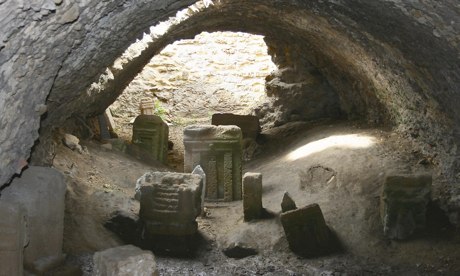
"This is something dismissed as black propaganda because in modern times people just didn't want to believe it," said Josephine Quinn, a lecturer in ancient history at Oxford, who is behind the study, with international colleagues, of one of the most bitterly debated questions in classical archaeology.
"But when you pull together all the evidence - archaeological, epigraphic and literary - it is overwhelming and, we believe, conclusive: they did kill their children, and on the evidence of the inscriptions, not just as an offering for future favours but fulfilling a promise that had already been made.
"This was not a common event, and it must have been among an elite because cremation was very expensive, and so was the ritual of burial. It may even have been seen as a philanthropic act for the good of the whole community."
Argument has raged on the subject since cemeteries known as tophets - after the biblical account of a place of sacrifice - were excavated in the early 20th century on the outskirts of Carthage in modern Tunisia, and then at other Carthaginian sites in Sicily and Sardinia. The graves held tiny cremated bones carefully packed into urns, buried under tombstones giving thanks to the gods. One has a carving which has been interpreted as a priest carrying the body of a small child. Some archaeologists and historians saw the finds as proving ancient accounts of child sacrifice; others insisted they showed tender respect for cherished children who died before or soon after birth.
Quinn and her colleagues, a group of Punic archaeologists and historians from Italy and the Netherlands, who publish their findings in the journal Antiquity - where the argument has been rumbling on for several years - completely reject the latter theory.
"The inscriptions are unequivocal: time and again we find the explanation that the gods 'heard my voice and blessed me'. It cannot be that so many children conveniently happened to die at just the right time to become an offering - and in any case a poorly or dead child would make a pretty feeble offering if you're already worried about the gods rejecting it."
"Then there is the fact that the animals from the sites, which were beyond question sacrificial offerings, are buried in exactly the same way, sometimes in the same urns with the bones of the children."
Although hundreds of remains were found, there were far too few to represent all the stillbirth and infant deaths of Carthage. According to Quinn, there were perhaps 25 such burials a year, for a city of perhaps 500,000 people.
The Roman historian Diodorus and other ancient historians gave graphic accounts of Carthaginian child sacrifice:
"There was in their city a bronze image of Cronus, extending its hands, palms up and sloping towards the ground, so that each of the children when placed thereon rolled down and fell into a sort of gaping pit filled with fire."Diodorus even said that some citizens who bought children from poor people and reared them specially for sacrifice believed misfortunes had resulted because they had not sacrificed their own offspring.
The argument has been passionate for years, with scientists often reaching opposed conclusions from the same bone fragments: four years ago a group of scientists published a paper saying the cremated remains did not indicate infant sacrifice.
Now in the same issue as Quinn's research, Antiquity is publishing a new paper on the same bones, insisting that the earlier study got the science of burnt infant bones wrong, and therefore greatly overestimated the number who died before birth rather than being murdered in infancy.
Quinn said many of her academic colleagues were appalled by her conclusions.
"The feeling that some ultimate taboo is being broken is very strong. It was striking how often colleagues, when they asked what I was working on, reacted in horror and said, 'Oh no, that's simply not possible, you must have got it wrong.'"
"We like to think that we're quite close to the ancient world, that they were really just like us - the truth is, I'm afraid, that they really weren't."



Reader Comments
to our Newsletter